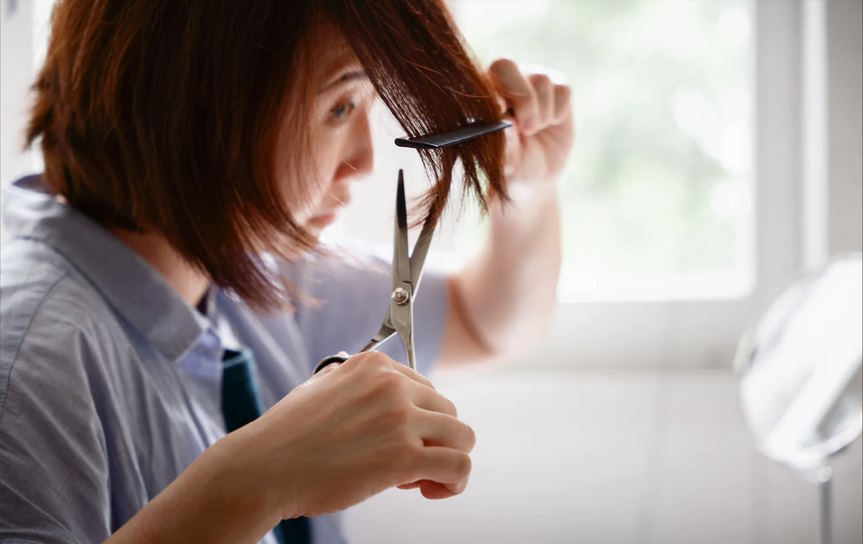The Importance of Regular Trims: How Often Should You Cut Your Hair?

Maintaining healthy and beautiful hair is a priority for many people, and regular trims play a crucial role in achieving this goal. However, the question of how often to cut your hair can be a bit tricky to answer. Some people may go months without a trim, while others may be frequent visitors to the salon. In this blog post, we’ll explore the importance of regular trims, the factors determining how often you should cut your hair, and some tips for keeping it looking and feeling its best. Whether you’re trying to grow out your locks or just looking for a healthy, polished look, understanding the importance of regular trims is key to achieving your hair goals.
Maintaining healthy hair with frequent haircuts: Exploring the advantages of regular trims
Regular hair trims may seem like a small and insignificant task, but they can make a significant difference in the health and appearance of your hair. Here are three benefits of getting regular trims:
Preventing split ends and breakage:
Split ends and breakage are a common problem for many people, especially those with longer hair. These issues occur when the ends of the hair become dry and brittle, leading to breakage and frayed ends. Regular trims can help prevent this problem by removing damaged ends before they can travel up the hair shaft and cause more damage.
Keeping hair healthy and manageable:
Getting a trim can help keep your hair healthy by removing any damaged or dead ends that can hinder hair growth. Regular trims can also keep your hair manageable by reducing tangles and making it easier to comb and style.

Maintaining hair’s shape and style:
If you have a specific hairstyle or cut, regular trims are essential for maintaining the shape and style of your hair. Over time, hair can grow out of shape, lose its style, or become uneven. Regular trims can help keep your hair looking its best by maintaining its shape and style.
Regular trims are essential to maintaining healthy, manageable, and stylish hair. By preventing split ends and breakage, keeping hair healthy and manageable, and maintaining hair’s shape and style, regular trims can make a significant difference in the health and appearance of your hair.
How to know when it’s time for a trim
Knowing when it’s time to get a trim is essential to maintaining healthy hair. Here are three signs that it’s time for a trim:
Signs of damage or breakage:
It may be time for a trim if you notice split ends, hair breakage, or rough and dry hair texture. These signs indicate that your hair is damaged and needs to be cut to prevent further damage from traveling up the hair shaft.
Changes in hair texture or style:
If you notice a change in your hair texture or style, such as increased frizz or unruly hair, it may be time for a trim. Changes in hair texture or style can occur naturally over time, but they can also be caused by damage or split ends.
Recommended timeframe between trims:
The recommended timeframe between trims varies depending on the person and their hair type. Generally, it’s recommended to get a trim every six to eight weeks. However, if you have longer hair or are trying to grow your hair out, you may be able to wait longer between trims.
It’s essential to know when it’s time for a trim to maintain healthy, manageable, and stylish hair. Look for signs of damage or breakage, changes in hair texture or style, and consider the recommended timeframe between trims based on your hair type. By getting regular trims, you can keep your hair looking its best and prevent further damage.

Tips for maintaining healthy hair between trims
Maintaining healthy hair between trims is just as important as getting regular trims. Here are three tips for keeping your hair healthy and looking its best:
Proper hair care and styling techniques:
Proper hair care and styling techniques are essential for maintaining healthy hair. This includes using a gentle shampoo and conditioner, avoiding hot tools, and air-drying your hair as often as possible. Using a wide-toothed comb or brush is also important to avoid tangles and breakage.
Avoiding damaging hair practices:
Certain hair practices can damage your hair, such as using hot tools too often, pulling your hair too tightly into a ponytail, or using chemical treatments. Avoiding these practices and being gentle with your hair to prevent damage and breakage is important.
Using the right products for your hair type:
Using the right hair products for your hair type can make a significant difference in the health and appearance of your hair. For example, if you have dry hair, you may want to use a moisturizing hair mask or leave-in conditioner. On the other hand, if you have oily hair, you may want to use a clarifying shampoo or avoid heavy products.
Maintaining healthy hair between trims is crucial for keeping your hair looking its best. You can keep your hair healthy, shiny, and manageable by using proper hair care and styling techniques, avoiding damaging hair practices, and using the right products for your hair type.
